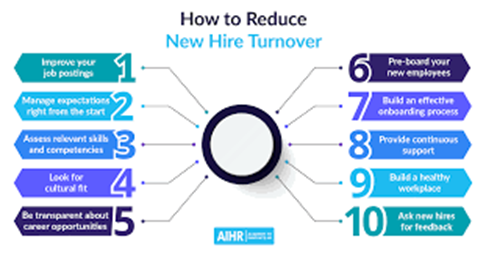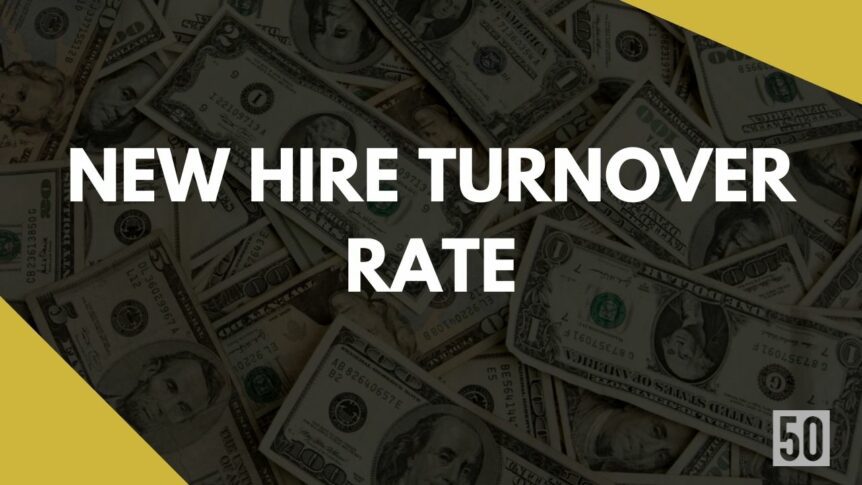Employers are always looking for ways to decrease their new hire turnover rate. According to recent studies, the average cost of replacing a salaried employee is about six months’ salary. This can be a huge expense for businesses, especially considering all the resources that go into recruiting and training new employees. Fortunately, there are some things employers can do to help reduce this number. Here are four tips to help get you started.
What is New Hire Turnover Rate?
The New Hire Turnover Rate is the percentage of new hires who leave the company within a given period. This metric is used to track the overall turnover rate for new hires, and can help identify problem areas within the onboarding process. A high New Hire Turnover Rate can indicate several issues, such as poor job fit, lack of engagement, or inadequate training. By tracking this metric over time, companies can identify trends and take steps to improve the overall retention of new employees.
Why Is It Important For Startups To Track This Metric?
Startups need to track the new hire turnover rate to identify how successful their recruitment process is. By monitoring the data, startups get insights into why employees leave so soon after being hired and if any patterns in these exits can be addressed. Knowing this metric also allows startups to compare themselves against industry standards, allowing them to adjust their recruitment processes and make improvements.
Additionally, tracking turnover rate gives startups an idea of their team’s morale and the amount of investment they need to put into retention strategies. Tracking new hire turnover rates helps startups create a better workplace culture and keep talent engaged for longer periods of time. Ultimately, having this information can help startups make more informed decisions about the future of their business.
How do you calculate New Hire Turnover Rate?
Here is the formula:
( # of separations during the time period / average number of employees during the same time period ) * 100 = New Hire Turnover Rate
Calculating your company’s New Hire Turnover Rate involves taking the number of separations during a given period and dividing it by the average number of employees during the same period. This will give you a percentage to compare against industry averages or your company’s historical data.
When gathering the data for this metric, it is important to establish what is considered a separation. For example, consider hires who have passed probation or those who have left within the first year. Additionally, it is best to use data from the same period to get an accurate picture. For instance, if you are looking at New Hire Turnover Rates for 2020, use employee data from 2020. By taking these steps, you can calculate an accurate New Hire Turnover Rate for your company.
What factors affect New Hire Turnover Rate?
Here are some factors that affect new hire turnover rate:
Poor Fit
One of the most common reasons why new hires leave is because they need to be a better fit for the role or organization. This could be due to mismatched expectations, lack of qualifications, cultural mismatch, or other reasons.
Lack of Training and Development
A great onboarding program can help new hires acclimate to the organization, but if they don’t have the necessary resources and training to do their job well, they may become frustrated and quit.
Poor Job Performance
If a new hire is not performing up to expectations or having difficulty completing tasks independently, they may be more likely to leave.
Poor Management
Managers who are not supportive or who don’t provide feedback can cause new hires to become discouraged, leading to higher turnover rates.
Unclear Goals and Expectations
If new hires don’t understand what is expected of them, they may feel overwhelmed and confused, resulting in lower performance and higher turnover rates.
Uncompetitive Compensation
If a position is not offering competitive wages or benefits, it may be difficult to retain new hires, especially if they are offered better opportunities elsewhere.
Poor Company Culture
A toxic work environment or an unbearable commute can lead to high turnover rates among new hires who may be looking for a better job elsewhere.
Lack of Recognition and Reward
If new hires feel that their work is not appreciated or rewarded, they may become discouraged and seek out opportunities elsewhere.
Poor Working Conditions
If the office environment is uncomfortable or unproductive, it can lead to lower morale and higher turnover rates.
These are just some of the factors that can lead to high new hire turnover rates. It is important for employers to understand these factors and take steps to mitigate them in order to create a successful onboarding process that leads to long-term employee retention.
The consequences of a high new hire turnover rate
A high new hire turnover rate can be costly for a company in several ways. Not only does it require extra time and resources for recruitment and training, but it can also disrupt the workflow and lower morale amongst the staff. In addition, if an employee is paid $50,000 annually, it will cost the company $25,000-$37,500 to replace them. As a result, companies must take measures to prevent high new hire turnover rates. Investing in employee retention strategies can dramatically reduce the financial and operational costs associated with employee turnover.
A high new hire turnover rate can have several consequences for a company. First, it can lead to increased training and orientation costs as the company continually needs to onboard new employees. Second, it can negatively impact employee morale as existing staff members are asked to pick up the slack. And finally, it can damage the company’s reputation and make it more difficult to attract top talent. In order to avoid these consequences, companies need to focus on creating a positive work environment and providing adequate resources for employee development. By taking these steps, they can reduce turnover rates and create a more stable and productive workforce.
How to identify when a new hire turnover rate becomes problematic?
Turnover rates can be tricky to decipher. Is your new hire turnover rate high? How can you tell if it’s problematic? Context is key here- look at your company’s size, industry, and geographical location. Then, compare your findings to others in similar situations. If your turnover rate is higher than average, that could indicate a problem.
Additionally, look at the cost of turnover. How much does recruiting, hiring, and training a new employee costs? If this number is high, that turnover is likely taking a toll on your bottom line. Use these benchmarks to help you assess whether or not your new hire turnover rate is problematic.
For example, If it costs $5,000 to hire and train a new employee and your turnover rate is 10%, you’re spending $500 for each person. However, reducing your turnover rate by 2.5% will save $12,500 per 100 employees ($500 x 25 employees). Another way to look at it is to calculate your company’s “cost of turnover.” This considers the direct costs of recruiting and training and the indirect costs associated with decreased productivity and morale. If you’re seeing a high turnover rate, it’s essential to address the situation. Otherwise, you could face some serious financial consequences.
Case Study: Naked Wine’s commitment to hiring well
Naked Wines commits to hiring well, which starts with its recruiting and onboarding process. By taking the time to screen candidates and ensure they are a good fit for the company, they can avoid many common issues that can lead to high turnover. In addition, they provide new hires with a clear understanding of expectations and offer ongoing support to help them succeed in their role. As a result, Naked Wines has created a strong team committed to providing quality service to its customers. This commitment has played a key role in their success as a business.

They have a policy of paying their employees three months’ salary after their probation period if they leave. This might seem odd, but it is actually a clever way to reduce the long-term costs of turnover. By paying their employees to leave, they avoid the costs of training and onboarding new employees and lose productivity due to unsuitable jobs. This policy saves the company money and ensures it has a high-quality workforce.
In addition to this commitment to hiring well, Naked Wine also gives its new hires a list of tasks to accomplish in their first month. This helps them understand both their new role and the company’s culture. As a result, Naked Wine is a company committed to its employees and its bottom line.
What is a good New Hire Turnover Rate?
New hire turnover is a major issue for employers. Not only is it expensive to replace employees, but it can also disrupt workflow and cause morale issues. While there’s no explicit definition, new hire turnover usually refers to the number of employees who leave a company within their first year on the job. The rate can vary depending on the industry, but it’s typically around 20%. To put that into perspective, for every 10 employees you hire, 2 will probably leave within the first year.
Reducing new hire turnover is essential for any business. By taking the time to screen candidates, invest in training, and create a positive work environment, you can set your company up for success.
What are tips to decrease New Hire Turnover Rate?
Here are some tips to decrease New Hire Turnover Rate:
Develop a comprehensive onboarding and orientation program
A well-thought-out onboarding and orientation program helps to ensure that new hires start off on the right foot. This can include training in company processes, policies, job duties, and expectations, introducing them to the team, and providing resources for ongoing support.
Make sure new hires are a good fit
Carefully and thoroughly assess whether a job candidate is right for the position and the company. Ask key questions, such as why they want to work at your organization, how their skills fit in with their future responsibilities, and their passions.
Implement effective communication
Communication between new hires and managers is key to successful onboarding. Set expectations from the beginning, provide feedback on performance throughout the process and make sure new hires feel comfortable asking questions about their roles.
Use technology for seamless onboarding.
To streamline the onboarding process, utilize digital platforms such as video conferencing, online assessments, and automated documents.

Offer competitive benefits and perks
Make sure that the benefits and perks you offer are competitive with those of other businesses in the industry. This will help attract top talent who value working in a positive, supported environment.
Provide mentorship opportunities
A mentor can provide guidance, advice, and support to new hires. This helps them adjust more quickly and gives them the tools they need to succeed in their roles.
Connect with employees regularly
Regular check-ins with employees show that you care about their overall job satisfaction and are invested in their development. Take the time to get to know your employees, provide feedback on their work, and ensure their job needs are met.
Invest in ongoing education and training
Provide new hires with the tools they need to stay up to date with industry trends and advancements. This can include access to webinars, seminars, reading materials, or other educational resources.
By following these tips, businesses can create an environment that reduces new hire turnover rate and encourages employee retention. Developing a comprehensive onboarding program, making sure new hires are a good fit, utilizing technology for seamless onboarding, offering competitive benefits and perks, providing mentorship opportunities, connecting with employees regularly, and investing in ongoing education and training will help companies facilitate successful onboarding experiences and retain new hires.
Conclusion
You can decrease your new hire turnover rate by increasing the clarity of expectations, building a support network, and having regular check-ins. These are just a few ways to set your new hires up for success. What have you done to decrease your new hire turnover rate?

